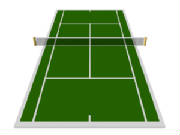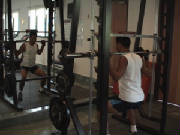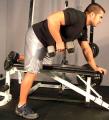
|
||||||
|
Two main goals of tennis training : |
|
Introduction
Most top players tend to be tall and particularly well developed in their musculature. If you are tall, you are better equipped to serve, volley and smash, while your long reach will help you get to the places that smaller people can not, especially at the net. If you are not, do not blame your parents but work hard on some of the points mentioned below. Your musculature is also something that is governed by genetics but it can be improved with training. Strength and power are increasingly important in the modem game. It goes without saying that there is a considerable element of skill in tennis, but there comes a point, as in most sports, where natural flair and skills practice are not enough.
In summary, tennis training has two main goals:
1. To achieve change in your body and mind. You can achieve that by pushing yourself into uncomfortable feelings and states, which "tell" your body and mind to adapt.2. To maintain the current state if it has reached its maximum potential. Again, you need to demand 100% effort from your body and mind to maintain this maximum potential. Otherwise they will change back to a state that is sufficient for current demands.
 |
That's how to achieve the fastest and biggest change of your current state.
Motivation. Without it, the player will not push into these uncomfortable feelings/states and therefore will either not improve or improve at a very low rate.
That's why only players with very strong internal motivation become top players, since they were able to endure hours and hours of grueling tennis training, which in the end made them fast, fit, mentally tough masters of tennis technique and strategy.

It's not your
bankbook that determines worth
It's not the color or texture of your skin
It's your attitude that lets you win
Demands of the game
Unlike a race, where there is a set distance to cover, or a soccer match, with a fixed lime limit, tennis is very unpredictable. If you are Steffi Graf, you can mop up an opponent in less than an hour, whereas a men's five setter can go on for four hours or more. This means you must be prepared for the worst eventuality, up to three hours for women and five for men. Endurance in such matches is a key factor, since when you get tired mistakes creep in and your attention starts to wander.
The surface you play on is important too because it can dictate the length of the rallies. On fast grass they tend to be shorter and more explosive, while on a slower clay surface they can last for 20 strokes or more, depending on your skill and your opponent's. Once again, endurance counts. Playing tennis for fitness, even on clay, is not the answer to aerobic conditioning.
The training week
The structure of a tennis player's week differs from that of most sports, partly because of the unpredictability I have mentioned. You may be banking on a week's hard slog in a particular tournament, then get knocked out in the first round. In addition, much of your training week will be spent in hours of court practice, grooming your serve and drilling ground strokes down the line. Physical conditioning must be built carefully into this schedule so as not to interfere with your racket practice. Strength training should be aimed not only at toning the muscles involved but also at redressing the inevitable imbalances that can occur as a result of using one side of your upper body much more than the other, so as to help prevent injury.

Phases of training
Peaking is not an important factor in tennis, at least for professionals. They can find a tournament somewhere throughout the whole year to earn their bread and jam. But if your goal is to win a club or county tournament, then the opportunity for peaking is far more possible. You may perform more endurance and basic strength development exercises during the off season, then concentrate more on agility and sharpness in the months approaching the event.
On court you can perform shuttles forwards and backwards, from baseline to service line and back, touching the ground with your
hand at each turn. Moving from the centre of the court to the left hand tram lines, back and to the right hand tram lines
quickly, always facing the net, is another way of practising fast, fluent court movement. Each journey can be covered a number
of times to form reps, while reps can be added to form sets. Timing these reps will help you monitor progress. Alternatively,
a coach or friend can randomly call the direction for you to move, forwards, backwards, left, right, so that you practice
changing direction quickly in response to the unexpected.
In the weights room you should choose exercises to train muscles in the upper and lower body, particularly the legs, lower and upper back,
shoulders and arms. Body weight exercises may also help these areas and the abdominals. A series of exercises performed one
after the other can form a "circuit", which you can repeat after a couple of minutes' recovery. Regular flexibility work will
also help prevent injuries and can add to the range of movement. Building in a 30 minute daily session , concentrating on
both lower and upper body, will complement the schedule well. Drills on and off court can improve your ability to move your
feet quickly into the correct position, while short, intense shuttle exercises to increase speed, followed by adequate recovery
to maintain quality, will help you cover the court quickly and effectively.

An element of aerobic conditioning will help your endurance. Running is useful because you spend your time on court on your feet but cycling and swimming can also condition your heart and lungs without the wear and tear from pounding out the miles, and may be enjoyed as an active recovery.
- Increase your general work capacity
- Improve your ability to tolerate increasing levels of muscular fatigue (stamina improvement)
- Elevate heart rates to upgrade your cardiorespiratory capacity (stamina improvement).
- Enhance your overall body strength, including the strength and resiliency of muscles, tendons, and ligaments, the integrity of your joints, and the strength and density of your supporting bone structures (strength improvement).
- Improve your movement skill and body awareness. You'll perform exercises that utilize body weight as the primary form of resistance (skill improvement).
- Increase your lean muscle mass by a moderate amount and decrease your body-fat levels through high levels of energy expenditure (body composition improvement)
Although not every match is going to be a five-set spectacular, you have to cover for that eventuality!











